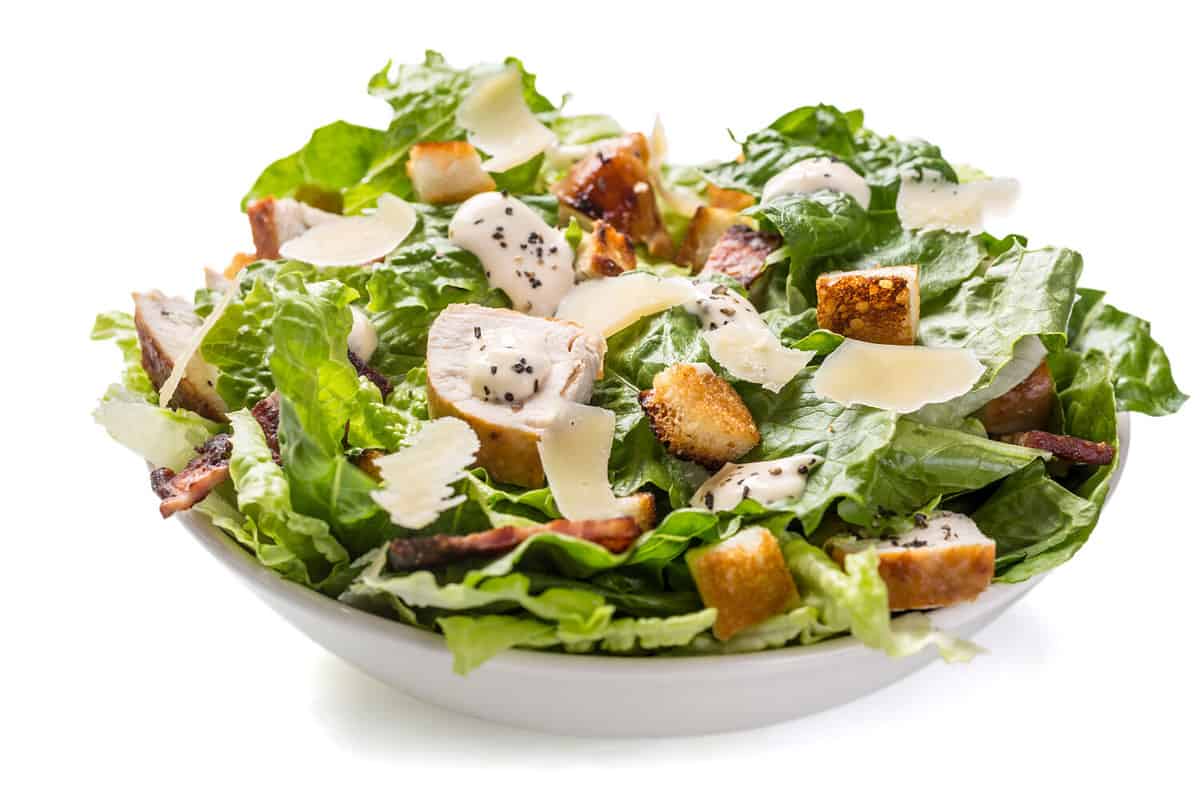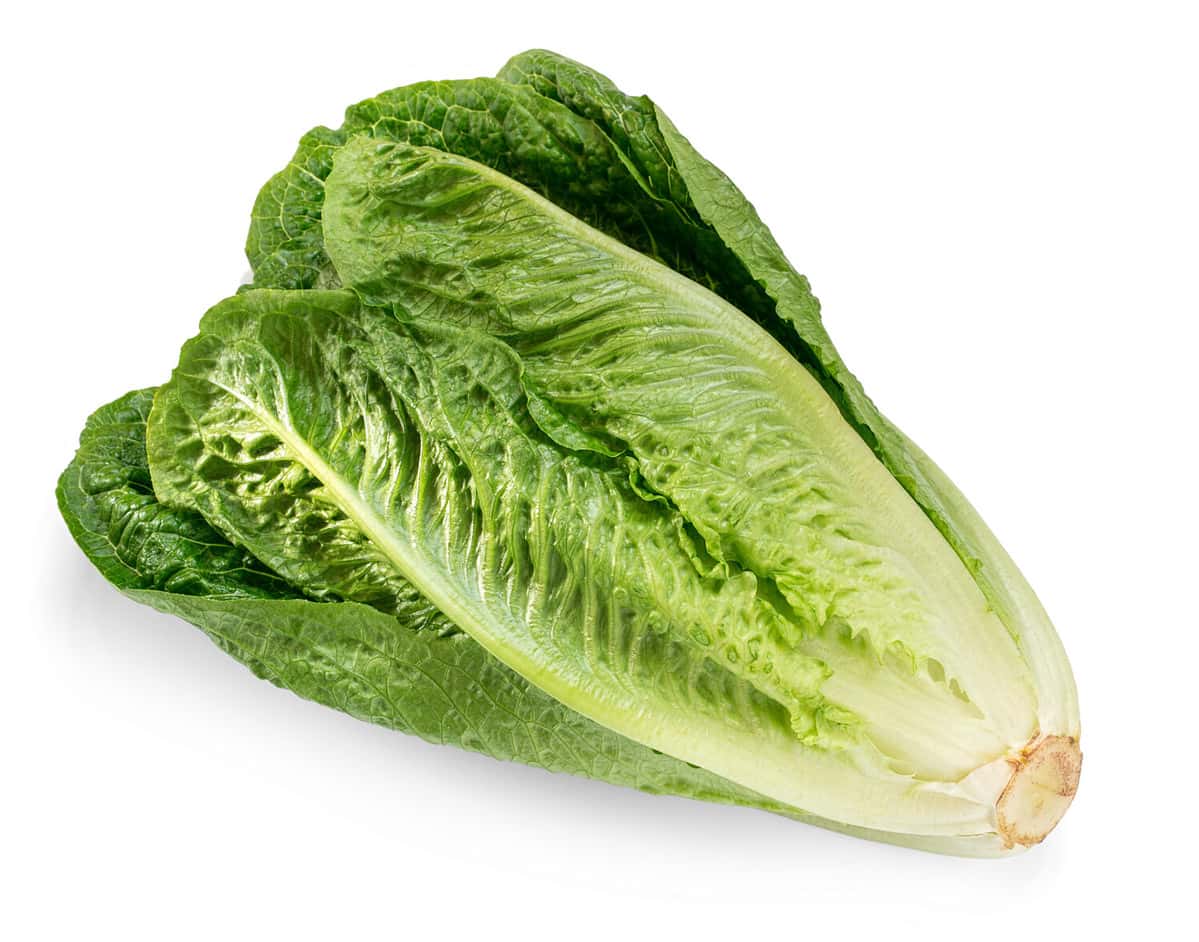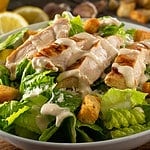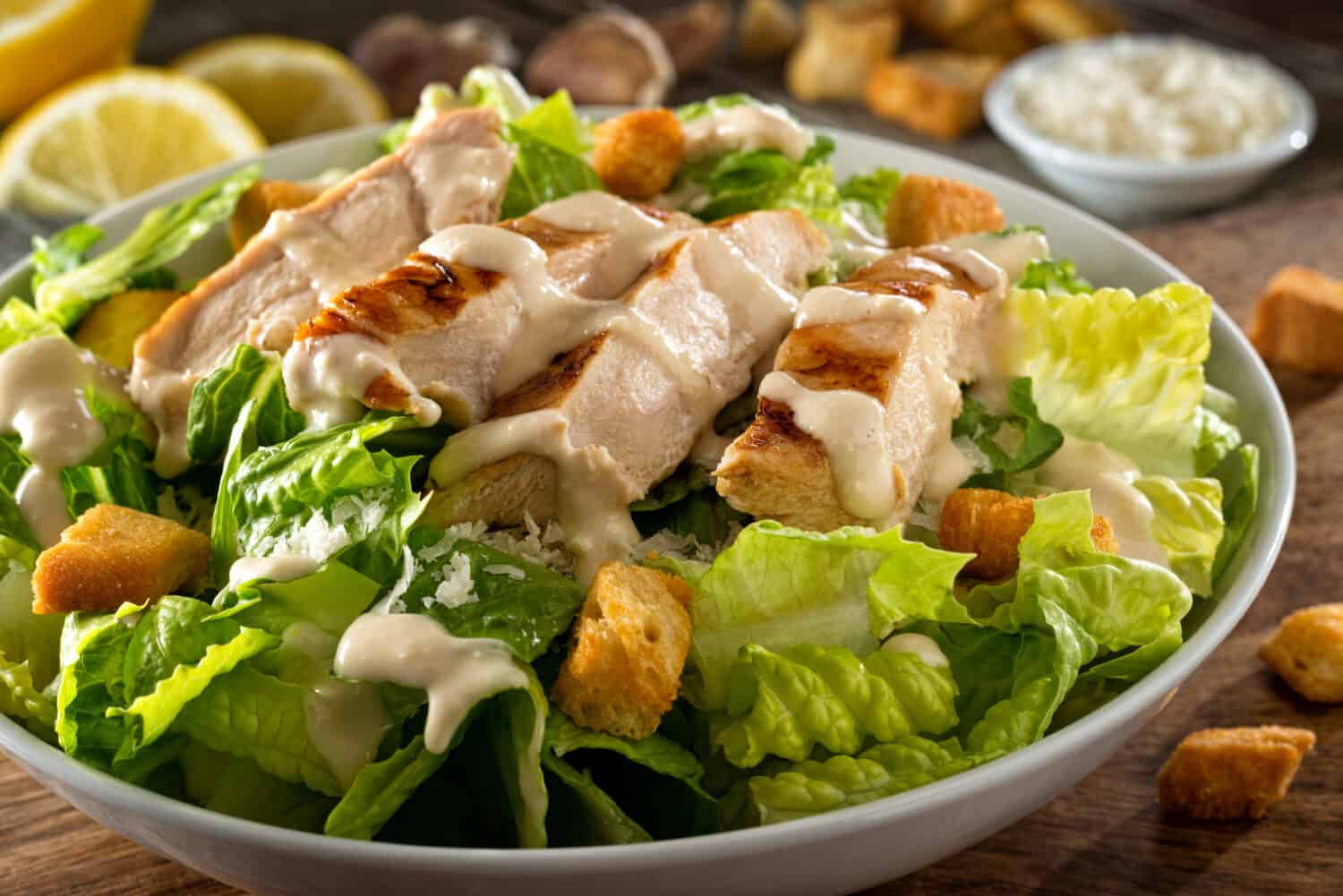Caesar salad is a popular salad that most families choose to add to their dinner meals as a healthy side dish. However, one should consider the ingredients used, the salad dressing, and their nutritional values to make the perfect Caesar salad. In this article, we will discover the benefits of eating Caesar salad, its nutritional value, and healthy salad dressing options you can choose from. Let's go!

©Olga Nayashkova/Shutterstock.com
What Is a Caesar Salad?
This delightful green salad consists of croutons and romaine lettuce. It is then dressed with olive oil, Worcestershire sauce, garlic, lemon juice, egg yolks, Parmesan cheese, ground black pepper, Dijon mustard, and anchovies. Created by Caesar Cardini, this salad is now a world-renowned staple.
He was an Italian immigrant who worked in restaurants in the United States and Mexico. Though he lived in San Diego, he also ran a restaurant in Tijuana, outside of the United States alcohol prohibition restrictions. During this period, many pilots would fly to Tijuana to procure alcohol, often stopping at Ceaser's restaurant, which led to the kitchen almost running empty on the fourth of July, 1924. Using his chef skills, he made the most of the leftover supplies and created the “Aviator Salad,” providing food for the influx of pilots. This was later renamed after its creator as the “Caesar salad” we know and love today.
Ingredients in Caesar Salad
Today, Caesar salads have a variety of ingredients. Apart from romaine lettuce, sometimes kale, bell peppers, avocado, and tomatoes are added to make it more nutritious. The lettuce provides fiber and vitamins; however, the dressing adds fat, and the croutons add carbohydrates. You will also find that instead of adding croutons, some chefs use whole-grain ciabatta or cornbread for healthier options. It is also served with a protein such as tofu, salmon, or grilled chicken. Let's take a closer look at the ingredients in a Caesar salad.

©Mongolka/Shutterstock.com
Romaine Lettuce
Romaine lettuce is low in calories. It is rich in fiber, vitamins, and minerals. A research study in October 2016 found that there are more minerals in romaine lettuce than in iceberg lettuce. It also has a decent amount of vitamin A, which is important for keeping our skin and eyes healthy. Additionally, it contains folate, which is vital for cell growth and reduces the risk of birth defects. The leaves contain a milky fluid, which gives it a bitter taste.
Lemon Juice
Lemons contain soluble fiber and are a good source of vitamin C, which supports the immune system. There are about 31 g of vitamin C in one lemon. It adds a fresh touch and brings out the flavors of the salad. Furthermore, lemon juice helps your blood cholesterol levels and can reduce your risk of kidney stones and heart disease. It also helps with weight loss. Lemons are often added to foods to help bring out the flavor.
Parmesan Cheese
Parmesan cheese is a famous Italian hard cheese that is rich in protein. It is a good source of vitamin A, potassium, magnesium, sodium, phosphorus, and calcium; however, it is also high in calories and fat. For every 100g, there are approximately:
- Fiber – 0g
- Calories – 392
- Carbohydrates – 3.57g
- Protein – 35.71g
To avoid gaining weight, parmesan cheese should be consumed in moderation.
Olive Oil
Olive oil is extracted from olives; it contains anti-inflammatory properties and is high in antioxidants and monosaturated fats. Specialists have agreed that extra-virgin olive oil has more health benefits. Next, olive oil contains oleic acid, which is a monounsaturated fat and accounts for 73% of the oil’s total content. Oleic acid has been linked to having valuable properties that may reduce cancer genes and inflammation.
Furthermore, olive oil contains nutrients that can kill bacteria. Studies have shown that extra virgin olive oil can fight eight different types of bacterium. One of these bacterium such as Helicobacter pylori lives in the stomach and can cause stomach cancer and ulcers.
Croutons
Croutons are a source of carbohydrates that provide the body with energy. These pieces of stale bread are usually added to a Caesar salad. However, be mindful that croutons are often high in sodium and calories. 100 g of croutons contain 407 calories. It would be advised to ask the chef for a healthier alternative, like whole wheat or chickpeas, or eliminate them depending on your personal dietary needs.
Anchovies
Anchovies are small fish; they are rich in omega-3 and are usually added to a Casesor salad for extra protein. Omega-3 is beneficial for the heart and brain However, it is important to note that anchovies can also be high in sodium, which can increase high blood pressure and cause heart disease.
Worcestershire Sauce
Worcestershire sauce is a common condiment used in many culinary dishes. It is filled with antioxidants that benefit the skin and vitamin B6, which helps boost the immune system. Furthermore, Worcestershire sauce also contains vitamin C, which protects the body against free radicals and improves your digestion. Keep in mind that Worcestershire sauce is also high in sodium and should be used in moderation.
Nutritional Values of Caesar Salad
Depending on the ingredients used and your portion sizes, Caesar salad can be healthy. It is best to add a protein like tofu, chicken seeds, or nuts. Additionally, when choosing your salad dressing, opt for a low-calorie vinaigrette or Greek yogurt dressing.
A 100g serving provides the following:
| Serving Size | Caesar salad without dressing | Caesar salad with regular dressing 1 Tablespoon | Caesar salad with “light” dressing 1 Tablespoon | Caesar salad with chicken and regular dressing 1 Tablespoon | Caesar salad with chicken and light dressing |
|---|---|---|---|---|---|
| Protein | 4g | 5g | 4g | 9g | 9g |
| Saturated Fat | 2g | 3g | 2g | 2g | 1g |
| Calories | 74 | 156 | 91 | 142 | 77 |
| Carbohydrates | 7g | 7g | 10g | 3g | 6g |
| Sodium | 225mg | 407mg | 286mg | 444mg | 434mg |
| Total Fat | 4g | 12g | 4g | 11g | 3g |
| Fiber | 2g | 2g | 2g | 3g | 2g |
| Cholesterol | 8mg | 14mg | 8mg | 29mg | 23mg |
| Iron | 5% | 5% | 5% | 5% | 5% |
| Calcium | 9% | 9% | 9% | 5% | 5% |
Conclusion
Finally, Caesar salad can be healthy depending on the ingredients used so the next time you consider Caesar salad opt for fresh vegetables and bright green romaine lettuce as it has higher minerals than iceberg lettuce, and choose a light salad dressing. So go ahead and try a chicken Caesar salad tonight.
Recipe Card
Print
Chicken Caesar Salad
Ingredients
- 4 (1 oz.) slices of French bread
- vegetable cooking spray
- 1/2 teaspoon garlic powder
- 2 pounds boneless chicken breasts
- 1/3 cup fresh lemon juice
- 1/4 cup red wine vinegar
- 1 Tablespoon olive oil
- 1 teaspoon anchovy paste
- 1/4 teaspoon fresh ground pepper
- 1/2 teaspoon minced garlic
- 9 cups Romaine lettuce
- 1/4 cup Grated Parmesan cheese
Instructions
- Trim bread crusts and discard. Cut bread into 1-inch cubes.
- Place cubes in a single layer on a baking sheet. Coat cubes with cooking spray; sprinkle with garlic powder; toss well.
- Bake at 350 degrees F for 15 minutes or until lightly browned and set aside.
- Coat a large nonstick skillet with cooking spray; place over med-high heat until hot. Add chicken halves; sauté 6 minutes on each side or until well done.
- Remove chicken from skillet; let cool. Cut chicken across the grain into thin slices; set aside.
- Combine lemon juice and the next 5 ingredients in a container of an electric blender. Cover and process until smooth.
- Add 1/4 cup of the lemon juice mixture to the chicken; toss gently to coat.
- In a large salad bowl, place the lettuce. Drizzle the remaining lemon juice mixture over the lettuce and toss well.
- Add the chicken mixture and cheese, and toss gently to coat. Serve with croutons.
The image featured at the top of this post is ©Foodio/Shutterstock.com.

